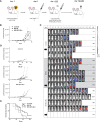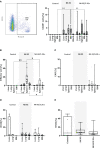ErbB2 (HER2)-CAR-NK-92 cells for enhanced immunotherapy of metastatic fusion-driven alveolar rhabdomyosarcoma
- PMID: 37662907
- PMCID: PMC10471977
- DOI: 10.3389/fimmu.2023.1228894
ErbB2 (HER2)-CAR-NK-92 cells for enhanced immunotherapy of metastatic fusion-driven alveolar rhabdomyosarcoma
Abstract
Introduction: Metastatic rhabdomyosarcoma (RMS) is a challenging tumor entity that evades conventional treatments and endogenous antitumor immune responses, highlighting the need for novel therapeutic strategies. Applying chimeric antigen receptor (CAR) technology to natural killer (NK) cells may offer safe, effective, and affordable therapies that enhance cancer immune surveillance.
Methods: Here, we assess the efficacy of clinically usable CAR-engineered NK cell line NK-92/5.28.z against ErbB2-positive RMS in vitro and in a metastatic xenograft mouse model.
Results: Our results show that NK-92/5.28.z cells effectively kill RMS cells in vitro and significantly prolong survival and inhibit tumor progression in mice. The persistence of NK-92/5.28.z cells at tumor sites demonstrates efficient antitumor response, which could help overcome current obstacles in the treatment of solid tumors.
Discussion: These findings encourage further development of NK-92/5.28.z cells as off-the-shelf immunotherapy for the treatment of metastatic RMS.
Keywords: ERBB2 (HER2/neu); cancer immunotherapy; chimeric antigen receptor; rhabdomyosarcoma; xenograft.
Copyright © 2023 Heim, Moser, Kreyenberg, Bonig, Tonn, Wels, Gradhand, Ullrich, Meister, Koerkamp, Holstege, Drost, Klusmann, Bader, Merker and Rettinger.
Conflict of interest statement
J-HK has advisory roles for Bluebird Bio, Novartis, Roche and Jazz Pharmaceuticals. TT and WW are named as inventors on patents and patent applications related to the study therapeutic owned by their respective academic institutions. The remaining authors declare that the research was conducted in the absence of any commercial or financial relationships that could be constructed as a potential conflict of interest.
Figures






Similar articles
-
CAR-CIK vs. CAR-T: benchmarking novel cytokine-induced killer cells as solid tumor immunotherapy in ErbB2+ rhabdomyosarcoma.Front Immunol. 2025 Feb 3;16:1485817. doi: 10.3389/fimmu.2025.1485817. eCollection 2025. Front Immunol. 2025. PMID: 39963129 Free PMC article.
-
ERBB2-CAR-Engineered Cytokine-Induced Killer Cells Exhibit Both CAR-Mediated and Innate Immunity Against High-Risk Rhabdomyosarcoma.Front Immunol. 2020 Oct 19;11:581468. doi: 10.3389/fimmu.2020.581468. eCollection 2020. Front Immunol. 2020. PMID: 33193388 Free PMC article.
-
Retargeting of NK-92 Cells against High-Risk Rhabdomyosarcomas by Means of an ERBB2 (HER2/Neu)-Specific Chimeric Antigen Receptor.Cancers (Basel). 2021 Mar 22;13(6):1443. doi: 10.3390/cancers13061443. Cancers (Basel). 2021. PMID: 33809981 Free PMC article.
-
CAR-NK cell in cancer immunotherapy; A promising frontier.Cancer Sci. 2021 Sep;112(9):3427-3436. doi: 10.1111/cas.14993. Epub 2021 Jul 7. Cancer Sci. 2021. PMID: 34050690 Free PMC article. Review.
-
CAR-NK Cells: From Natural Basis to Design for Kill.Front Immunol. 2021 Dec 14;12:707542. doi: 10.3389/fimmu.2021.707542. eCollection 2021. Front Immunol. 2021. PMID: 34970253 Free PMC article. Review.
Cited by
-
CAR-CIK vs. CAR-T: benchmarking novel cytokine-induced killer cells as solid tumor immunotherapy in ErbB2+ rhabdomyosarcoma.Front Immunol. 2025 Feb 3;16:1485817. doi: 10.3389/fimmu.2025.1485817. eCollection 2025. Front Immunol. 2025. PMID: 39963129 Free PMC article.
-
CAR-NK cells for cancer immunotherapy: recent advances and future directions.Front Immunol. 2024 Feb 9;15:1361194. doi: 10.3389/fimmu.2024.1361194. eCollection 2024. Front Immunol. 2024. PMID: 38404574 Free PMC article. Review.
-
Advancing Natural Killer Cell Therapy: Genetic Engineering Strategies for Enhanced Cancer Immunotherapy.Ann Lab Med. 2025 Mar 1;45(2):146-159. doi: 10.3343/alm.2024.0380. Epub 2025 Jan 8. Ann Lab Med. 2025. PMID: 39774132 Free PMC article. Review.
-
Precision targeting of rhabdomyosarcoma by combining primary CAR NK cells and radiotherapy.J Immunother Cancer. 2025 Jul 7;13(7):e011330. doi: 10.1136/jitc-2024-011330. J Immunother Cancer. 2025. PMID: 40623716 Free PMC article.
-
Advances in CAR-NK cell therapy for lung cancer: is it a better choice in the future?Front Oncol. 2024 May 28;14:1390006. doi: 10.3389/fonc.2024.1390006. eCollection 2024. Front Oncol. 2024. PMID: 38863635 Free PMC article. Review.
References
Publication types
MeSH terms
Substances
LinkOut - more resources
Full Text Sources
Research Materials
Miscellaneous

